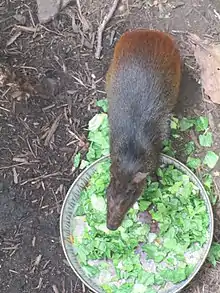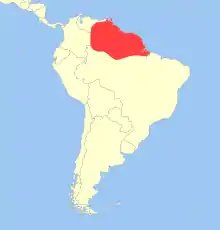Red-rumped agouti
The red-rumped agouti (Dasyprocta leporina), also known as the golden-rumped agouti, orange-rumped agouti or Brazilian agouti, is a species of agouti from the family Dasyproctidae. It is native to northeastern South America, where found in Venezuela, Guyana, Suriname, French Guiana, northeastern Brazil, and Trinidad and Tobago. It has also been introduced to the U.S. Virgin Islands, Grenada, and Dominica.[2] Despite the alternative name Brazilian agouti, it is neither the only nor the most widespread species of agouti in Brazil. In Brazil all agoutis are often called "cutia" [kuˈtʃiɐ].
| Red-rumped agouti | |
|---|---|
.jpg.webp) | |
| Red-rumped Agouti at Asa Wright Nature Centre, Trinidad and Tobago | |
 | |
| Red-rumped agouti eating from a dish in the Henry Vilas Zoo, Madison, Wisconsin | |
| Scientific classification | |
| Kingdom: | Animalia |
| Phylum: | Chordata |
| Class: | Mammalia |
| Order: | Rodentia |
| Family: | Dasyproctidae |
| Genus: | Dasyprocta |
| Species: | D. leporina |
| Binomial name | |
| Dasyprocta leporina | |
 | |
| Geographic range | |
| Synonyms | |
|
Mus aguti Linnaeus, 1766[2] | |
It is found in a wide range of forests, including rainforest and secondary forest.[1]
Description
Red-rumped agoutis weigh about 3 to 6 kilograms (6.6 to 13.2 lb). They are about 19 to 25 inches (48 to 64 cm) long. In this species the females are larger than males but otherwise look similar. They are brownish with darker spots on the upper body. The fur becomes more orange as it goes past (going down) the middle area of the animal. The ears are somewhat square in shape. The front feet have 4 toes and the back have 3. They can be distinguished from other agoutis by their distinct coloring.
These animals have no distinct breeding season, and females generally have about 1 to 3 young. The gestation period is 104 to 120 days. On average, it takes 20 weeks for the young to be weaned. They live in pairs or family groups of the parents and little ones. They need large areas for food, breeding, and territory. It is hard to keep the animal in captivity for that reason. Most animals in the family Dasyproctidae mate once or twice, and this is presumed to be true for this species as well. This species lives 15-20 yrs in captivity.
They are known to feed on and disperse Astrocaryum aculeatissimum seeds. [3]
References
- Emmons, L. & Reid, F. (2008). "Dasyprocta leporina". IUCN Red List of Threatened Species. 2008. Retrieved 5 January 2009.CS1 maint: ref=harv (link)
- Woods, C.A.; Kilpatrick, C.W. (2005). "Infraorder Hystricognathi". In Wilson, D.E.; Reeder, D.M (eds.). Mammal Species of the World: A Taxonomic and Geographic Reference (3rd ed.). Johns Hopkins University Press. pp. 1538–1600. ISBN 978-0-8018-8221-0. OCLC 62265494.
- Pires, Alexandra; Galetti, Mauro (December 2012). "The agouti Dasyprocta leporina (Rodentia: Dasyproctidae) as seed disperser of the palm Astrocaryum aculeatissimum". Mastozoologia Neotropical. 19 (1).
External links
 Media related to Brazilian Agouti at Wikimedia Commons
Media related to Brazilian Agouti at Wikimedia Commons Data related to Brazilian Agouti at Wikispecies
Data related to Brazilian Agouti at Wikispecies
